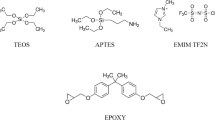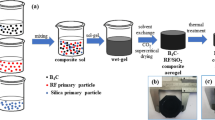Abstract
In the present work, RF/SiO2 aerogels reinforced by zirconia (ZrO2) were fabricated by a sol–gel process combined with N2-ethanol supercritical drying. The physical properties and microstructures of the aerogels were investigated by uniaxial compression, X-ray diffraction, N2 physico-adsorption, scanning electron microscopy, X-ray photoelectron spectroscopy, and infrared spectrum. The compressive strengths of the aerogels were improved obviously with the addition of ZrO2. The composite aerogels remained amorphous state even the percentage of ZrO2 reached up to 6.77 wt%. The pore sizes of the aerogels with various ZrO2 were hierarchical and the Brunauer-Emmett-Teller surface area increased distinctly with the increase of ZrO2. On the contrary, the aerogel particle sizes decreased as the increase of ZrO2. In our opinion, the enhanced compressive strengths derive from both of the varied pore structures and the decrease of the particle sizes.
Graphical Abstract









Similar content being viewed by others
References
Kong Y, Zhong Y, Shen XD, Cui S, Zhang JJ, Yang M (2012) Facile synthesis of resorcinol–formaldehyde/silica composite aerogels and their transformation to monolithic carbon/silica and carbon/silicon carbide composite aerogels. J Non-Cryst Mater 20:3150–3155
Kong Y, Zhong Y, Shen XD, Gu L, Cui S, Yang M (2013) Synthesis of monolithic mesoporous silicon carbide from resorcinol–formaldehyde/silica composites. Mater Lett 99:108–110
Leventis N, Sadekar A, Chandrasekaran N, Leventis C (2010) Click synthesis of monolithic silicon carbide aerogels from polyacrylonitrile-coated 3D silica networks. Chem Mater 22:2790–2803
Hasegawa G, Kanamori K, Nakanishi K, Hanada T (2009) Fabrication of macroporous silicon carbide ceramics by intramolecular carbothermal reduction of phenyl-bridged polysilsesquioxane. J Mater Chem 19:7716–7720
Chen K, Bao Z, Du A, Zhu X, Wu G, Shen J, Zhou B (2012) Synthesis of resorcinol–formaldehyde/silica composite aerogels and their low-temperature conversion to mesoporous silicon carbide. Micro Meso Mater 149:16–24
Kong Y, Shen XD, Cui S, Zhong Y (2014) Effect of carbothermal reduction temperature on microstructure of fiber reinforced silicon carbide porous monoliths with high thermal resistance. Chinese J Inorg Chem 12:2825–2831
Kong Y, Shen XD, Cui S, Fan M (2014) Preparation of monolith SiC aerogel with high surface area and large pore volume and the structural evolution during the preparation. Ceram Inter 40:8265–8271
Maleki H, Duraes L, Portugal A (2014) An overview on silica aerogels synthesis and different mechanical reinforcing strategies. J Non-Cryst Solid 385:55–74
He J, Li X, Su D, Ji H, Wang X (2016) Ultra-low thermal conductivity and high strength of aerogels/fibrous ceramic composites. J Euro Ceram Soc 36:1487–1493
Yi X, Zhang L, Wang F, Shen X, Cui S, Zhang J, Wang X (2014) Mechanically reinforced composite aerogel blocks by self-growing nanofibers. RSC Adv 4:48601–48605
Zhong Y, Kong Y, Shen X, Cui S, Yi X, Zhang J (2013) Synthesis of a novel porous material comprising carbon/alumina composite aerogels monoliths with high compressive strength. Micro Meso Mater 172:182–189
Scott HG (1975) Phase relationships in the zirconia-yttria system. J Mater Sci 10:1527–1535
Schlichting KW, Padture NP, Klemens PG (2001) Thermal conductivity of dense and porous yttria-stabilized zirconia. J Mater Sci 36:3003–3010
Brinker CJ, Scherer GW (1990) Sol-gel science: the physics and chemistry of sol-gel processing, Academic Press Inc, San Diego.
Chen XH, Yang SX, Song HH (2006) Preparation and characterization of RF/SiO2 hybrid aerogel by sol-gel method. Adv Mater Res 11-12:619–622
Nagarajan VS, Rao KJ (1989) Crystallization studies of ZrO2–SiO2 composite gels. J Mater Sci 24:2140–2146
Monte F, Larsen W, Mackenzie D (2000) Chemical interactions promoting the ZrO2 tetragonal stabilization in ZrO2–SiO2 binary oxides. J Am Ceram Soc 83:1506–1512
Liu Q, Lu Z, Zhu M, Yuan Z, Yang Z, Hu Z, Li J (2014) Simulation of the tensile properties of silica aerogels: the effects of cluster structure and primary particle size. Soft Matter 10:6266–6277
Cordero ZC, Knight BE, Schuh CA (2016) Six decades of the Hall–Petch effect:a survey of grain-size strengthening studies on pure metals. Int Mater Rev 61:495–512
Acknowledgements
B.L., W.J., J.Z., H.F., Q.W., X.Y. acknowledge financial support from National Natural Science Foundations of China (Nos. 51402176, 21603125), Shandong Provincial Natural Science Foundation of China (ZR2016EMP04), the Young and Middle Aged Scientists Research Awards Fund of Shandong Province (BS2013CL038), the Science and Technology Development Plan Project of Shandong Province (2013YD02046). Z.Y., X.W. acknowledge financial support from National Natural Science Foundations of China (51372140). We are thankful for Shuxian Wang from Department of Material Science and Engineering, Jinan University for the help of compressive strength test.
Author information
Authors and Affiliations
Corresponding author
Ethics declarations
Conflict of interest
The authors declare that they have no competing interests.
Rights and permissions
About this article
Cite this article
Liu, B., Ju, W., Zhang, J. et al. Improvement of mechanical strength of ultralight resorcinol–formaldehyde/silica aerogel by addition of zirconia. J Sol-Gel Sci Technol 83, 100–108 (2017). https://doi.org/10.1007/s10971-017-4400-5
Received:
Accepted:
Published:
Issue Date:
DOI: https://doi.org/10.1007/s10971-017-4400-5




